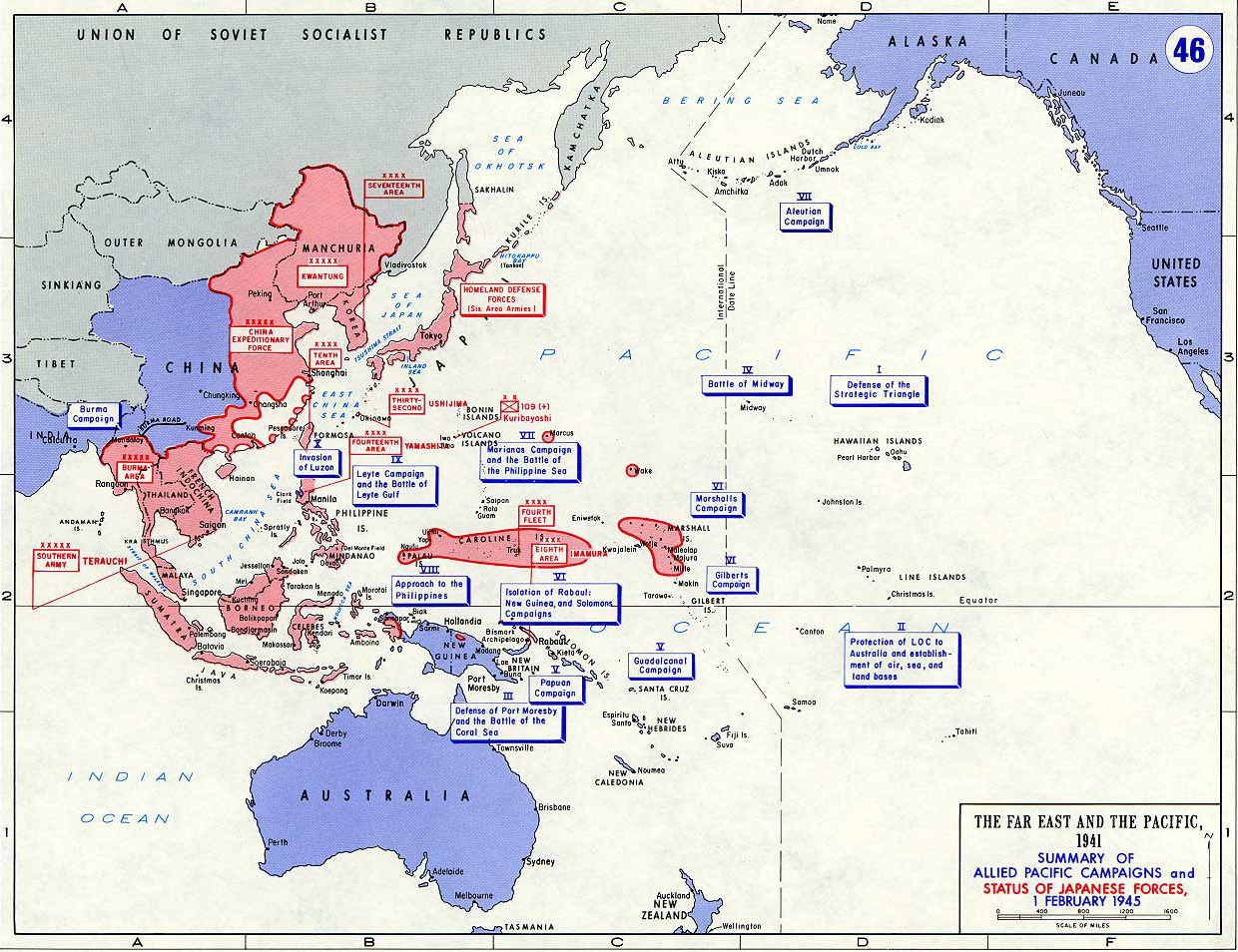Map Description
History Map of WWII: The Far East and the Pacific 1945
Illustrating:
Summary of Allied Pacific Campaigns
and
Status of Japanese Forces, February 1, 1945
In detail:
:: Summary of Allied Pacific Campaigns ::
-
Burma Campaign
December 1941 – August 1945 (main Allied offensives: 1944–1945)
Outcome/Winner: Allies (successful)
-
Protection of Lines of Communication (LOC) to Australia and establishment of air, sea, and land bases
Early 1942 – 1943
Outcome/Winner: Allies (successful)
Note: In early 1942 the Allies focused on maintaining vital supply and communication routes between the US and Australia, establishing bases in New Caledonia, Fiji, and elsewhere. These efforts were successful and formed the logistical backbone for later campaigns.
-
Defense of the Strategic Triangle (Java, Port Darwin, New Caledonia)
Early 1942
Outcome/Winner: Allies (strategic withdrawal, but ultimately held key bases)
Note: The Allies lost Java but retained Port Darwin and New Caledonia, preventing Japanese control of the South Pacific.
-
Defense of Port Moresby and the Battle of the Coral Sea
May 4–8, 1942 (Coral Sea); May–Sept 1942 (Port Moresby)
Outcome/Winner: Allies (strategic victory)
Note: The Battle of the Coral Sea was the first naval battle where opposing ships never sighted each other; it was a strategic Allied victory as the Japanese advance toward Port Moresby was halted.
-
Battle of Midway
June 4–7, 1942
Outcome/Winner: Allies (decisive US victory)
-
Aleutian Campaign
June 1942 – August 1943
Outcome/Winner: Allies
Note: The Japanese occupied Attu and Kiska; Allies retook both islands.
-
Papuan Campaign (including Kokoda Track and Buna-Gona)
July 1942 – January 1943
Outcome/Winner: Allies
Note: The Papuan Campaign marked the first major Allied land victory against Japan.
-
Guadalcanal Campaign
August 7, 1942 – February 9, 1943
Outcome/Winner: Allies
-
Isolation of Rabaul: New Guinea and Solomons Campaign
1943 – 1944
Outcome/Winner: Allies (Rabaul neutralized)
-
Gilberts Campaign (Battle of Tarawa, Makin)
November 20–23, 1943
Outcome/Winner: Allies
-
Marshalls Campaign (Kwajalein, Eniwetok)
January 31 – February 23, 1944
Outcome/Winner: Allies
-
Approach to the Philippines (Western New Guinea, Morotai, Palaus)
April – September 1944
Outcome/Winner: Allies
-
Marianas Campaign and the Battle of the Philippine Sea
June 15 – August 10, 1944 (Marianas); June 19–20, 1944 (Philippine Sea)
Outcome/Winner: Allies
-
Leyte Campaign and the Battle of Leyte Gulf
October 17 – December 26, 1944 (Leyte); October 23–26, 1944 (Leyte Gulf)
Outcome/Winner: Allies
Note: Largest naval battle of WWII; decisive Allied victory, opening the Philippines to liberation.
-
Invasion of Luzon
January 9 – August 15, 1945
Outcome/Winner: Allies
Note: Led to the liberation of the main Philippine island.
:: Status of Japanese Forces, February 1, 1945 ::
By February 1945, Japanese forces faced severe strains across multiple theaters. Below is a detailed breakdown of key units and
their operational statuses. This disposition shows Japan transitioning to static defense while preparing for decisive homeland battles.
Seventeenth Area Army (Korea)
The Seventeenth Area Army was responsible for defending southern Korea against potential Allied amphibious invasion. This force was composed of the 120th Division and 150th Division, though both units had limited armor and artillery support. While the army focused on establishing coastal fortifications, it lacked sufficient troop strength due to the diversion of resources to other fronts throughout the war.
Kwantung Army (Manchuria)
Once Japan's most elite military force, the Kwantung Army had become severely depleted after transferring over twenty divisions to Pacific theaters since 1943. By this time, the army was reduced to approximately 600,000 troops, consisting mostly of inexperienced conscripts equipped with outdated equipment. The remaining forces were preparing static defenses against the growing Soviet military buildup along the Manchurian border.
China Expeditionary Army
The China Expeditionary Army controlled 1.05 million troops spread across China, but these forces were stretched thin fighting both Nationalist and Communist forces. Key formations within this command included the North China Area Army, which was responsible for securing railways and coal mines, the 6th Area Army, which defended the Wuhan region, and the 23rd Army, which guarded the Guangdong coast.
Southern Army (Saigon)
Under the command of Field Marshal Hisaichi Terauchi, the Southern Army commanded approximately 700,000 troops across Southeast Asia. Major units within this force included the Burma Area Army, which had been reduced to 85,000 men following the disastrous Imphal offensive, the 7th Area Army, responsible for defending Malaya and Sumatra, and the 18th Area Army, which remained isolated in Thailand.
Tenth Area Army (Taiwan)
The Tenth Area Army was tasked with defending Formosa (Taiwan) and the Ryukyu Islands. This command included the 32nd Army stationed on Okinawa, which consisted of 77,000 troops preparing elaborate cave defenses. Naval support for these operations remained limited following the destruction of the Combined Fleet at the Battle of Leyte Gulf.
Fourteenth Area Army (Philippines)
General Yamashita's Fourteenth Area Army had been reduced to 250,000 troops on Luzon following the defeat at Leyte. The remaining forces were implementing the "Shō-Gō 1" defense plan, which utilized the mountainous terrain of the region to create defensive positions against advancing Allied forces.
Other Critical Garrisons
Several other critical garrison positions remained under Japanese control. On Iwo Jima, General Kuribayashi commanded 21,000 troops who had completed an extensive underground tunnel network. At Truk, Fourth Fleet remnants remained isolated due to Allied air superiority. Meanwhile, the Eighth Area Army's 90,000 troops at Rabaul had been effectively neutralized by Allied containment strategies.
Homeland Defense
For the defense of the Japanese home islands, six newly formed Area Armies (the 11th through 16th) commanded 2.35 million troops. However, these forces faced significant challenges as they lacked heavy weapons, with only 40% of artillery needs being met. The armies relied heavily on poorly trained conscripts and civilian militias, and had deployed Kamikaze units as their primary anti-invasion strategy.
Credits
Courtesy of the United States Military Academy Department of History.
Related Links
About the Second Sino-Japanese WarAbout the Second World War
WWII Timelines

